Definition
Artificial gravity (AG) is not gravity at all. It is not a field force or a ”force at a distance.” Neither does its strength obey the inverse square law of attraction that determines the orbital motion of planets. However, in terms of its action on any mass, it is indistinguishable from ”real gravity.” Instead of gravitational pull, it exerts a centrifugal force, proportional to the mass that is being accelerated centripetally in a rotating device. Although the effect of AG on an extended body differs from that of true gravity, the effects on any given mass are equivalent. Thus AG is simply the imposition of acceleration on a body to recover the forces that are eliminated by the free fall of orbital flight. (Of course, real gravity is not eliminated in orbit. The pull toward Earth in Earth orbit and toward the Sun in interplanetary orbit is balanced by the ”free fall” acceleration of the spacecraft and its contents toward Earth or the Sun. To an observer or instrument onboard the spacecraft, it feels as though the pull of gravity were removed.)
Provision of AG
In principle, AG could be provided by various means. A continuously thrusting rocket that accelerated a spacecraft halfway to Mars would generate AG equal to the acceleration level. Intermittent impulsive AG would be imposed on an astronaut who jumps back and forth between two opposing trampolines or even between two stationary walls in a spacecraft. However, the term artificial gravity is generally reserved for a rotating spacecraft or a centrifuge within the spacecraft. Every stationary object within the centrifuge is forced away from the axis of rotation toward the outer ”floor” by a force proportional to the mass of the object, its distance from the center of rotation, and the square of the angular velocity of the device.
Why AG May Be Necessary
Probably the most serious health threat to humans during interplanetary flight comes from radiation exposure en route and on some extraterrestrial surface. Beyond that, prolonged exposure to weightlessness itself can result in de-conditioning many of the body’s systems. For space voyages of several years, such as those envisioned for exploration of Mars, the human requires some sort of ”countermeasure” to reduce or eliminate this de-conditioning. Intensive and sustained exercise on a treadmill, bicycle, or rowing machine was used on the U.S. and Russian spacecraft to minimize the problems of weightlessness. The procedure is uncomfortable and excessively time-consuming for most astronauts. Furthermore, its effectiveness is not proven for all users. Other kinds of countermeasures, including diet, fluid loading before reentry, lower body negative pressure, or wearing a ”penguin suit” to force joint extension against a resistive force are either marginally effective or present an inconvenience or hazard.
The physiological effects of weightlessness are generally adaptive to space flight and present a hazard only upon return to Earth or landing on another planet (1). However, they may present hazards in flight in the event of a bone fracture, a vigorous muscle contraction, or alterations in the heart’s rhythm.
Aside from the severe danger of space radiation, the principal physiological risk of long flight is deterioration of the skeleton. Bones are living tissue, constantly being strengthened by calcium extracted from the blood and destroyed by returning calcium to the blood. Bone maintenance requires a compressive load along the axis of the bone and some high-force impulsive loading. In the absence of these loads that are normally provided by gravity and walking, the major bones that support body weight begin to deteriorate, and a net loss of body calcium occurs, independent of the amount taken in with food or supplements. The long bones in the legs and the vertebrae in the spine lose crucial size and strength during prolonged bed rest. Similarly, they lose strength in spaceflight. Calcium is lost at a rate of about 1/2% per month, and the losses are reflected in the density and size of weight-bearing bones. For a spaceflight of two years, a 25% decrease in bone size might occur (unless the process reaches a plateau), thus increasing the risk of fracture and severely hampering the bone’s ability to mend.
Muscles involved in weight bearing, as well as bones, begin to weaken with disuse in weightlessness. The major muscle groups in the legs and back that normally support weight lose mass and are also “reprogrammed,” so that fibers previously devoted to slow steady tension are used for brief bursts instead. The shifting of fluid from the legs and lower trunk to the head and chest that produces the first symptoms of head-fullness discomfort on orbit initiates an early loss of body fluid, including blood plasma. The relative excess of red blood cells is countered by stopping their production in the bone marrow and additionally by destroying young red blood cells. The cardiovascular regulating system that acts to maintain adequate blood pressure when we stand up, is no longer needed in space and shows signs of deterioration. Neither the fluid loss and resulting ”space anemia,” nor the loss of cardiovascular regulation and tone normally cause any difficulty in orbit. During reentry and back on Earth, however, the renewed exposure to gravity can cause weakness and fainting.
The balance system that keeps humans from falling depends on the detection of gravity by the otolith organs in the inner ear. Because the only stimulus to the organs in weightlessness is linear acceleration, considerable reinterpretation of vestibular signals takes place. A consequence of this process is the common occurrence of space sickness early in flight and postural disturbances and vertigo after return.
The immune system that fights infection may also be compromised by space flight, although it is unclear whether weightlessness alone is the major factor.
In addition, a variety of human factor problems arise in weightlessness, including the constant need for handholds or footholds for stabilization and the possibility of disorientation within a spacecraft. However, these problems are often balanced by the ease of moving heavy objects, the use of three-dimensional space, and the shear pleasure of floating in weightlessness.
History of AG
The notion of creating a substitute for gravity through centrifugation was introduced early in the conception of human space travel. Tsiolkovsky, the influential Russian space visionary, discussed the idea in 1911, and his concepts were picked up 50 years later by Korolev, who designed a flexible tether system for the Voskhod manned missions (2). It was, however, never built. A detailed engineering proposal for an AG station was introduced by Noodhung in 1927, a full 50 years before the first satellite was launched. When Von Braun described his vision of space exploration in 1953, he included a large rotating torus to deal with weightlessness (Fig. 1) (3).
The popularization of AG, however, is attributable to the science fiction community. The large rotating torus in Clarke and Kubrick’s 2001: A Space Odyssey presented an idealized version of life in space, free of health problems and the negative effects usually associated with transiting from the rotating to the stationary parts of the station. By 1965, preliminary tests on a short-radius centrifuge first showed that subjects who were de-conditioned by bed rest could be protected against cardiovascular de-conditioning by periodic centrifugation (4).
Experience with AG in space has been quite limited. Rats were centrifuged continuously at 1 g for several days and showed no de-conditioning. Human experiments, however, have not been conducted to date. Early attempts to test AG by tethering a Gemini spacecraft to an Agena rocket were inconclusive and nearly led to disaster when the thruster nozzle stuck on Gemini 8, sending the pair of space vehicles into an uncontrollable spin. The 2.5-m-radius centrifuge on the International Space Station should afford the opportunity to examine the adequacy of various levels of AG in protecting rodents during spaceflight.
Design Boundaries
The envelope of operation for AG is limited by several factors, as pointed out by Von Braun and adapted by others. The ”comfort zone” for AG with a rotational radius of up to 1000 feet is bounded by several constraints (5). In one presentation, the nominal design point was for a 734-foot radius architecture, spinning at approximately 1.8 rpm. This large radius creates less than a 1% gravitational gradient from head to foot under a 4% ratio of Coriolis force to apparent weight for a crew moving at 3ft/s. The rim velocity would exceed 200ft/s. The basic design space is normally shown on a graph of rotational rate versus radius; the acceleration level appears as a derived parameter according to the equation A = ru?. The design boundaries have generally been stated for continuous rotation but are also shown here for intermittent centrifugation (Figs. 2a,b).
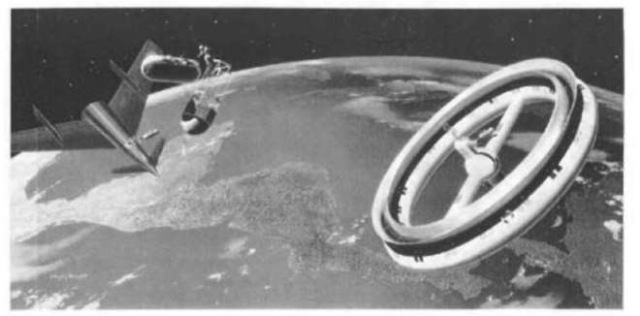
Figure 1. Von Braun’s rotating space station.
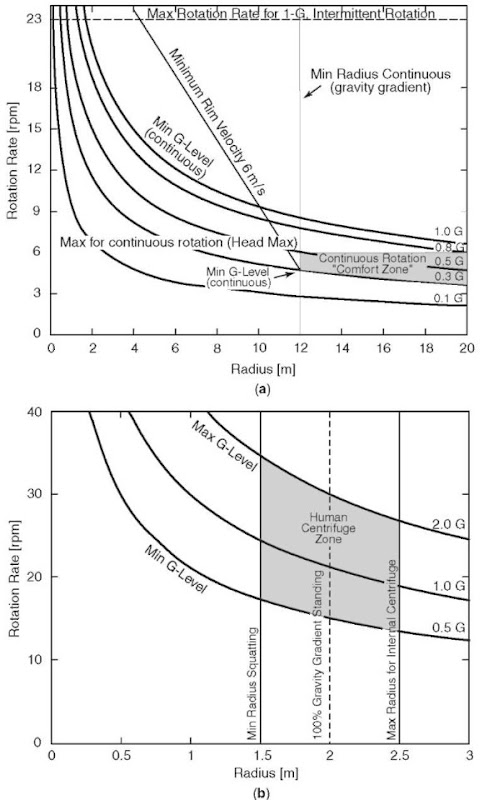
Figure 2. (a) Comfort zone for continuous AG (adapted from Reference 5). (b) Centrifuge zone for intermittent AG.
The minimum gravitational level, normally measured at the rim of a centrifuge, is the key parameter in the design space. The limited animal tests in orbit confirm that continuous rotation to yield 1 g at the feet of a small rodent is sufficient to maintain normal growth. However, it remains to be determined whether a lesser g level will suffice. Based on centrifuge studies of long duration, Russian scientists suggest that the minimum level of effective AG is about 0.3 g and recommend a level of 0.5 g to increase a feeling of well-being and normal performance.
The maximum gravitational acceleration level is also a factor if short-radius intermittent AG is used. Levels up to 2 g are probably useful, especially if combined with exercise, but a level as high is 3 g’s is likely to produce ill effects if maintained for more than 20 minutes.
The maximum angular velocity of the AG device is limited by the Coriolis forces encountered when walking or when moving objects, and by the motion sickness and disorientation experienced with certain kinds of head movements. Coriolis accelerations are real inertial accelerations that occur when moving within a rotating framework. Any movement in a straight line with respect to the rotating frame, except for one parallel to the axis of rotation, is in fact a curved motion in inertial space. The curve reflects acceleration sideways and entails a sideways inertial reaction force (Fig. 3).
People trying to walk radially outward on a spinning carousel will feel a surprising force pushing them sideways, parallel to the circumference. As seen by an observer stationed outside the carousel, the walker’s path is really curved in the direction of the carousel’s spin. The sideward inertial acceleration requires a sideward force (Coriolis force), according to Newton’s second law, and the subjects need to apply that unexpected force to avoid walking a path that is curved relative to the carousel. They also must apply an unexpected postural reaction to avoid falling over.
Additionally, anyone trying to walk along the rim of the AG spinning vehicle in the direction of the spin is subject to an unexpected radial inertial acceleration inward, which entails a downward Coriolis force, making the space walker feel heavier. If the astronaut were to turn around and walk along the rim in the direction opposite to the spin, the Coriolis force would be upward and the apparent weight of the astronaut would be reduced. The magnitude of the Coriolis force is given by the equation |Fc| = |moxv|. From considerations of human factors, the Coriolis accelerations should be kept to less than some fraction of the AG gravity level. Stone (5,6) suggests that this be no higher than one-fourth. For radial movement at velocity v, this is given by
![]()
where vrim is o times r and is the speed of the outer rim of the AG centrifuge. The minimum rim velocity is limited only by the need to maintain enough friction for locomotion when walking against the direction of spin. For walking, vmax is about 1 m/s, and it has been assumed that the estimated minimum rim velocity is 6 m/s.
The most disturbing aspect of AG rotation is probably the Coriolis cross-coupling accelerations detected by the semicircular canals in the vestibular systems of the inner ear. The organs function to detect angular velocity of the head relative to inertial space for most normal head movements. However, because of their mechanical structure, they fail to register long-lasting constant velocity motion and, instead, indicate that one is stationary in a turn that lasts more than 10-20 s. In AG, these vestibular signals are apparently inconsistent with what one sees in the spacecraft and also with the linear acceleration registered by the otolithic organs in the labyrinth. This conflict, before adaptation, produces both motion sickness and spatial disorientation.
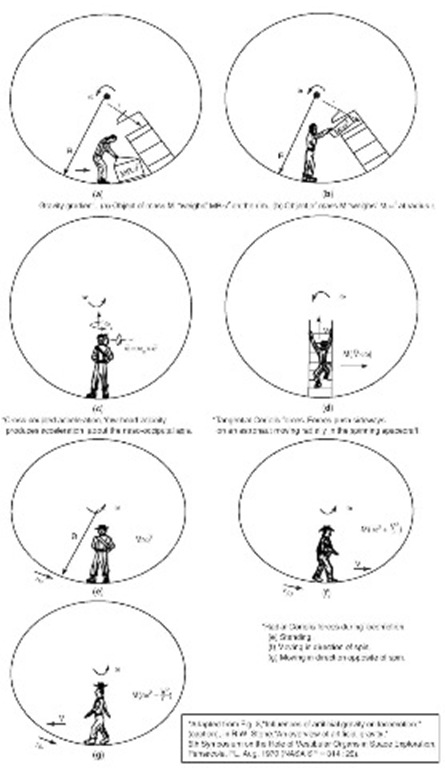
Figure 3. Coriolis forces.
When subjects in AG suddenly move their heads about an axis that is not parallel to the spin axis, two unexpected angular accelerations occur. First, during the head movement a ”cross-coupled acceleration” occurs, equal to the product of the spin rate and the head angular velocity that produces transient acceleration about a third orthogonal axis. This is given by the equation A = wy x os. Second, when the head is turned, the spin angular velocity is moved from one head plane to another, producing a sensation of deceleration about the first axis and acceleration about the second one. A sensation of rotation with components around both axes usually occurs for up to 10 sec, as the semicircular canals return to their neutral position. The directions of both the Coriolis force and the cross-coupled accelerations depends on the direction the subject is facing in the rotating spacecraft, as well as the direction of head movement, thereby complicating the process of general adaptation to the unusual environment.
All of the unexpected Coriolis sensations are proportional to the AG spin rate. Although further adaptative schedules might increase the tolerable rate, the maximum spin rate for continuous rotation has been estimated at 6 rpm, with possible elevation to 10 rpm. Almost all subjects can adapt quickly to work in a 2-rpm rotating environment. It is believed that most could tolerate increased rotational rates to 6-10 rpm, providing that they are built up slowly in steps of 1-2 rpm with a period of 12-24 h at each increment (7).
The gravitational gradient refers to the change in AG level with radius and can affect both physiological function and the ease of handling materials in space. Since the ”g level” is proportional to the radius, the gravitational gradient from head to foot is simply the ratio of height to radius: Gradient = h/R. For continuous rotation at smaller radii, comparable to the astronaut’s height, the gravitational gradient may become more of a problem. For a 2-m astronaut, the radius would be at least 4 m for a 50% maximum gradient.
Experimental Results
Space Experiments. Despite the long-standing interest in artificial gravity, experimental evidence from space is very limited. Only two space missions early in the space program were devoted to animal studies, and all of the human inflight results were anecdotal.
Flight Animal Experiments. The Soviet space research community expressed an early and intense interest in AG and, in 1961, began testing rats and mice in the 25-s weightless periods of parabolic flight. Animals showed normal appearing locomotion during these brief periods if they were housed in a centrifuge producing at least 0.3 g, thus setting this as a minimum g requirement (8). The first animals to be centrifuged in space were on the Cosmos 782 mission in 1975, when fish and turtles centrifuged at 1g were found indistinguishable from their ground controls. Furthermore, turtles centrifuged at levels as low as 0.3 g showed none of the muscle wasting typical of weightlessness. A much more extensive investigation was carried out on rats centrifuged during the 20-day mission of Cosmos 936 in 1977. These animals, housed in a small-radius (32-cm), high-speed (53.5-rpm) 1-g centrifuge, showed deficits in equilibrium and postural control post flight, consistent with the observed reduction in vestibular sensitivity. Faring less well than their ground controls, they also failed to counter fully the usual effects of weightlessness on loss of muscle and bone, circumstances that may have been the result of the small cage size and the high-g gradient. The large animal centrifuge planned for the International Space Station is designed to provide a range of AG levels, above and below 1 g, to a large variety of fish, plants, and small animals.
Human Space Experience with AG. No formal human AG experiments were performed in space during the first 40 years of the space age. During the earliest years of human spaceflight, the major physiological disturbances involved ”space adaptation syndrome” and were of concern only for the first few days in orbit. The debilitating effects of weightlessness on the bone, muscle, and cardiovascular system were demonstrated on the Skylab missions in the early 1970s and later on the long-duration Salyut and Mir flights. However, it was believed that in-flight exercise, augmented by resistance training and fluid loading, would solve the problem. As time passed, the opportunities for human centrifuges or rotating spacecraft in orbit disappeared. During a 1966 Gemini mission, an orbiting Agena rocket casing was tethered to the spacecraft, and the two were put into a slow spin. No data were taken. On Gemini 8, when Gemini was docked to the Agena, a planned slow rotation got out of control because of a stuck thruster, and the crew was saved only by the skillful use of an orbital maneuvering engine. No further spacecraft AG tests have been conducted. Since then, the only opportunities for investigation have come from uncontrolled, anecdotal reports.
During the Skylab missions, the crew took advantage of the large open compartment to run around the curved circumference. They produced a self-generated AG by running. The crew reported no difficulty with either locomotion or motion sickness.
Although no specific AG human experiments have been performed, some centrifugation for other purposes has produced a measure of centripetal acceleration. During the Spacelab International Microgravity Laboratory (IML-1) mission, subjects were spun on a rotator in which the head was 0.5 m off center, experiencing an acceleration of -0.22 gz, and the feet were on the other side of the axis, experiencing an acceleration of + 0.36 gz (9). No unusual inversion phenomena were reported. Similarly, in the Neurolab Spacelab mission, four subjects received periodic rotation in a similar situation without reorientation. In that case, however, those subjects seemed to have achieved some measure of resistance to post flight orthostatic instability and did not show the usual decrease in vestibular sensitivity to tilt (10).
Ground Centrifuge Experiments. Despite the absence of flight-test opportunities, several laboratories worldwide have continued ground-based studies of the efficacy and acceptability of human horizontal centrifugation. Of course, all of these investigations are hampered by the presence of the steady gravitational pull. Gravity adds to the centrifugal force vectorially and produces a net specific gravitoinertial force F=g — a directed between vertical and horizontal.
The earliest of the extensive tests of sustained rotation were conducted in Pensacola (11), beginning in 1958. The ”slow rotating room” (SRR) exposed volunteers to prolonged rotation (12). This 3-m-radius room that has a horizontal floor permitted subjects to adapt to rotation during several days (13,14). Initially, most subjects developed motion sickness symptoms when they made head movements at room rotational rates in excess of 3 rpm and, through that experience, learned to restrict them. Incremental increase in the speed of the room was employed. After several days, most subjects were able to make head movements without symptoms at rotational rates up to 6rpm. Only some of the subjects could go further to move comfortably at 10 rpm. When the rotation was stopped, subjects felt an aftereffect and an erroneous motion sensation during head movements. They were maladapted to rotation in the opposite direction.
Beginning in the 1960s a major ground research program on AG was conducted at the Institute for Biomedical Problems in Moscow (IBMP). Their earliest tests in the MVK-1 small rotating chamber at speeds up to 6.6 rpm allowed rotating one or two subjects for up to a week. It was followed by the roomier 10-m-radius ”Orbita” centrifuge, capable of rotating two to three people for several weeks at speeds up to 12 rpm. The longest tests were for 25 days at 6 rpm. The initial exposures produced the expected disturbance of equilibrium and coordination. Within an hour, the usual pattern of motion sickness symptoms occurred, including vomiting in some cases (15). In 4-5 hours, subjects also complained of listlessness, sleepiness, and headache—similar to the Sopite syndrome identified by Graybiel. Three periods of vestibular adaptation were distinguished for these long-duration exposures. The first 1-2 days were characterized by severe motion sickness. This was followed by a week during which the nausea and related acute symptoms disappeared, but listlessness and headache remained. Finally, after the first 7-10 days, subjects showed immunity to motion sickness, even when additional vestibular stimulation was imposed. The generalizability of this adaptation has not been determined. The Soviet centrifuge tests indicated an absence of any motion sickness symptoms at 1rpm, moderate symptoms at 1.8 rpm, and marked symptoms at 3.5 rpm. Head movements brought on discomfort in all cases.
More recent investigations have assessed the ability of subjects to avoid motion sickness during head movements while rotating at the high speeds associated with short-radius centrifugation. Antonutto and colleagues in Udine, Italy, found that subjects who were pedaling on a bicycle-powered short centrifuge were able to make head movements without acute motion sickness while rotating at 19-21 rpm. Young, Hecht, and colleagues used the 2-m-radius centrifuge at MIT to show that most subjects could adapt both their eye movements and their motion sickness symptoms to accommodate head movements while rotating at 23 rpm (16). Both the Udine and the MIT studies were conducted at speeds sufficient to produce 1 g of horizontal centripetal acceleration or a net gravitoinertial acceleration of 1.4 g’s. In the Udine centrifuge, it was aligned with the subject’s, head-to-foot axis, whereas in the more provocative MIT studies, the subject remained horizontal.
The Coriolis forces associated with limb movements, head movements, and walking in a rotating environment are initially both surprising and disturbing.
However, in almost all cases, appropriate new motor control strategies are developed, so that subjects can adapt to the new environment and no longer are even aware of the unusual forces. Extensive experiments in the Brandeis University rotating room demonstrate the remarkable ability to adapt to unusual environments (17). A measure of dual adaptation apparently exists, so that subjects can switch from the rotating to the nonrotating environment with minimal relearning.
The adequacy of artificial gravity in stimulating the cardiovascular system has been investigated in ground studies. In most studies, the debilitating effects of weightlessness are simulated by sustained bed rest, often at 6° of head-down tilt and occasionally by partial submersion in water to approximate the fluid shift better that occurs in space. In a pioneering study in 1966, White and his colleagues at Douglas (18) showed that intermittent exposure to 1g or 4g’s on a 1.8-m-radius centrifuge was effective in alleviating the usual decrease in tolerance to standing (orthostatic intolerance). Exercise produced little additional benefit. The principal cardiovascular reactions of interest for centrifugation are the venous tone, especially in the legs, and the baroreflex regulation of blood pressure. For a short-radius centrifuge small enough to accommodate a subject only in a squatting position, the centrifugation does little to encourage venous return by stimulating the muscles. The IBMP ground centrifuge tests (19) demonstrated that subjects who were deconditioned by 2 weeks of water immersion could increase their post-immersion tolerance to + 3gz by intermittent acceleration on a 7-m-radius centrifuge. For some time, it was debated whether the intermittent centrifugation conditioned only the passive motor tone or whether the body’s active baroreflex to counter the effects of gravity on blood pressure was also affected. Burton and Meeker (20), using a 1.5-m-radius centrifuge intermittently, showed that the bar-oreceptors are adequately stimulated during AG. Their slow compensation for the hydrostatic pressure drop during rotation permits the g tolerance to gradual onset acceleration to exceed that to rapid onset acceleration. Beyond even the benefit of intermittent acceleration on cardiovascular responses is the effect on blood volume. Normally, weightlessness or head-down bed rest produces a fluid shift toward the head that in turn leads to fluid loss, including plasma, and a resulting increase in hematocrit. However, Yajima and his colleagues from Nihon University School of Medicine in Tokyo (21) showed that 1hour per day of 2gz exposure of their subjects, using a 1.8-m-radius centrifuge, was sufficient to prevent hem-atocrit from increasing during a 4-day bed rest period. In other studies, they confirmed the effectiveness of intermittent centrifugation on maintaining baroreflex and parasympathetic activity (22). To prevent motion sickness, the Nihon investigators stabilized the head during these centrifuge runs.
The interaction between the cardiovascular fitness enhancement of regular exercise and the tolerance built up during centrifugation remains unclear. Certainly the two countermeasures are individually effective, but whether they contribute more in combination is still under study (23,24).
Artificial Gravity Design Options
The choice of AG design depends on a basic decision whether the crew is to be transported with continuous AG, requiring a large-radius device, or exposed to intermittent AG, in which case a small rotator can be employed. The classical large spinning space station, as epitomized by the von Braun torus, was the basis for early designs in the Apollo era (25). At one time, a large toroid 150 feet in diameter and constructed of six rigid modules joined by an inflatable material, was envisioned. The large mass and excess volume of a torus or hexagon forced consideration of other ways of generating centrifugal forces at large radii. The two that emerged are the rigid truss, or boom, and the tether concept. A rigid truss design typically would have the crew quarters and operations module at one end and a large counterweight at the other end. The counterweight might be an expended fuel tank or an active element such as a nuclear power source. In most cases a counterrotating hub is present at the center of rotation to provide both a nonspinning docking port and to allow for a zero-g workspace for experiments. A variation on the rigid truss is the extendable or telescoped boom concept, in which the radius of the AG systems could be varied more easily than with a fixed truss and slider. However, both of these designs imply considerably more mass and power requirements than a tether system. A variable length tether that could be unreeled in orbit and used to connect a spacecraft to a counterweight has emerged as the most acceptable design for a large AG system. As envisioned for a Mars mission (26), it would consist of a 80,000 kg habitat module 225 m from the center of mass, with a 44,000 kg counterweight 400 m beyond. The two are connected by a tether, weighing 2400 kg, reeled out by a deployer weighing 1700 kg. All told, the additional weight for accommodating a tethered AG system for a human Mars mission is about 21,000 kg, or about 5% of the 0-g weight, plus about 1400 kg of propellant (Fig. 4).
One of the obvious concerns about a tethered AG system is its vulnerability to tether breakage. For the Mars mission design, a tether in the form of a band 0.5 cm x 46 cm x 750 m would provide a dynamic load safety factor of 7, offering a working strength of (630,000 N). That concern has otherwise been addressed by using webbing or braided cable to maintain tether integrity, even in the event of a meteoroid collision. (The probability of tether impact with a micrometeoroid of mass greater than 0.1 gm was calculated as .001 for a mission of 420 days.) A second concern about a tethered system lies in its dynamic stability, especially during unreeling and during spin up and spin down. The interaction with orbital maneuvers is complex, whether the spin axis is inertially fixed or tracking the Sun to facilitate the use of solar panels.
The alternative approach to AG is to use a short-arm centrifuge intermittently. In this case, the exposure would not be limited to less than 1 g, but might be as high as 2 or 3 g’s to deliver adequate acceleration in exposures of perhaps 1 h daily or several times per week. Of course, such a short device would have to spin much faster than the 6 rpm limit envisioned for a large continuous system— and would produce significant Coriolis forces and motion sickness stimuli if the head is moved, at least until adaptation occurs. The short-radius centrifuge becomes particularly attractive when its dimensions shrink to the point that intermittent centrifugation could be carried out within the confines of a spacecraft, rather than entailing rotation of the entire complex. A 2-m-radius AG device permits subjects to stand upright and even walk within its limited confines. Of course, the head is then close to the center of rotation, and a significant gravitational gradient appears as one goes from head to toe. Many of the ground
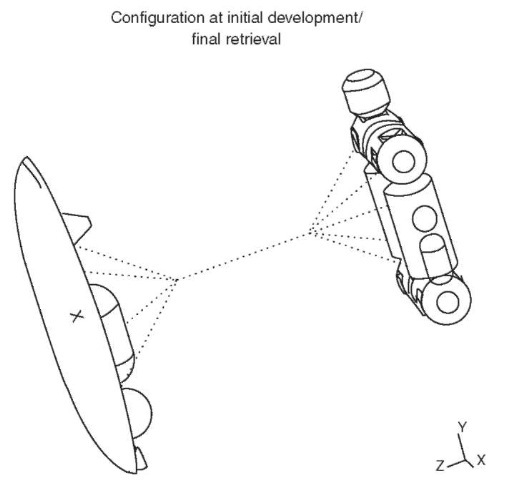
Figure 4. Tether design.
studies of intermittent short-radius centrifugation have been conducted with rotators of radius from 1.8-2.0 m. As the radius shrinks even further to less than 1.5 m, the taller subjects can no longer stand erect but must assume a squatting or crouching posture. For many such designs, the subject would also provide the power to turn the device and perform valuable exercise by bicycling the centrifuge into rotation (Fig. 5).
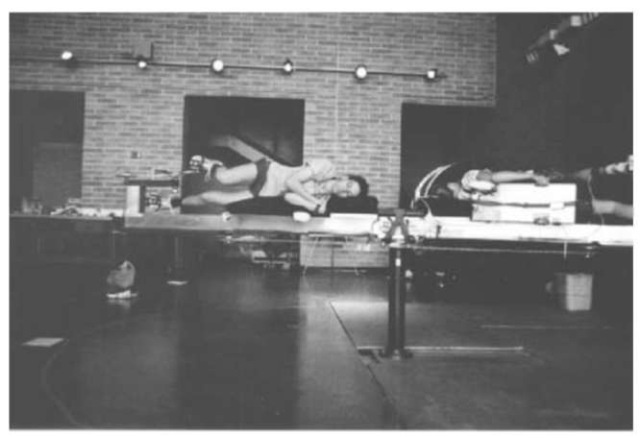
Figure 5. Bicycle-driven centrifuge courtesy of Dava Newman.
Although the power saving may be trivial, or not even used, the importance of active exercise while exposed to intermittent centrifugation might lie in its protection against syncope, or fainting, as the body is exposed to the unaccustomed footward forces that tend to pool blood in the lower extremities.
